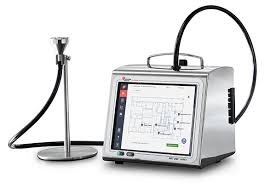SOP for METONE Laser Particle Counter

1.0 Purpose
To establish a procedure for the proper operation, calibration, and maintenance of the METONE Laser Particle Counter (LPC) used for monitoring airborne particulate contamination in controlled areas.
2.0 Scope
This SOP applies to all personnel trained to operate the METONE LPC for environmental monitoring in classified cleanrooms (Grades A, B, C, and D) of the facility.
3.0 Responsibility
- QC/Microbiology Department: To operate the LPC, perform monitoring, and record results.
- QA Department: To review and approve environmental monitoring reports.
- Engineering Department: To support calibration, maintenance, and troubleshooting.
4.0 Definitions
- LPC (Laser Particle Counter): Instrument used to count and size airborne non-viable particles in cleanrooms.
- METONE: A specific brand/model of laser particle counter widely used in pharmaceutical cleanrooms.
5.0 Materials and Equipment
- METONE Laser Particle Counter with isokinetic probe and tubing
- Tripod or portable stand (as applicable)
- Power source or charged battery
- Calibration certificate (annual or per manufacturer’s recommendation)
- Environmental Monitoring Logbook
6.0 Procedure
6.1 Pre-Operation Checks
- Verify that the LPC is within calibration period.
- Ensure the instrument is clean and free from damage.
- Verify tubing and isokinetic probe are sterile and intact.
6.2 Instrument Setup
- Place the LPC at the designated location inside the cleanroom.
- Attach sterile tubing and the isokinetic probe securely.
- Switch on the instrument and allow it to perform self-diagnostic checks.
- Set parameters:
- Sampling volume (e.g., 1 cubic foot / 28.3 L)
- Sampling duration (as per SOP/ISO 14644-1 requirements)
- Particle size channels (≥0.5 µm, ≥5.0 µm, or as required)
6.3 Sampling
- Position the probe at critical locations (e.g., filling line, background, laminar airflow workstation, airlocks).
- Avoid blocking the probe or creating disturbances during sampling.
- Start the sampling run and allow the instrument to collect the required volume.
- Record readings displayed on the screen after each run.
- Repeat sampling as per the environmental monitoring plan.
6.4 Post-Operation
- Switch off the LPC after sampling.
- Disconnect tubing and probe, discard sterile tubing as per procedure, and clean probe.
- Wipe external surfaces of the LPC with validated disinfectant.
- Return the instrument to the designated storage location.
7.0 Calibration and Maintenance
- Perform annual calibration through qualified vendor/manufacturer.
- Maintain calibration certificates for GMP compliance.
- Conduct preventive maintenance as per manufacturer’s recommendation.
8.0 Documentation
- Record sample location, date, time, particle counts, and operator initials in the Environmental Monitoring Logbook.
- Document any deviations or instrument errors.
- Attach printouts or electronic data (if applicable) to reports.
9.0 Acceptance Criteria
- Refer to ISO 14644-1 and EU GMP Annex 1 classification limits for airborne particulate contamination.
- Typical limits:
- Grade A: ≥0.5 µm: 3520 particles/m³; ≥5.0 µm: 20 particles/m³
- Grade B, C, D: As per Annex 1 table
10.0 Precautions
- Always handle LPC with care; avoid shocks or vibrations.
- Do not use expired/uncalibrated instruments.
- Ensure battery is charged before entering cleanrooms.
- Do not block airflow around isokinetic probe.
11.0 References
- ISO 14644-1: Cleanrooms and associated controlled environments — Classification of air cleanliness
- EU GMP Annex 1: Manufacture of Sterile Medicinal Products
- Manufacturer’s User Manual (METONE LPC)
🎓 Discover one of the best Pharmaceutical Microbiology course available —click below to explore the course that’s shaping future Microbiology course skills.

